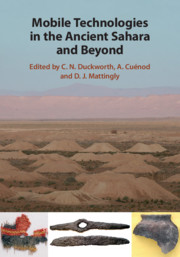Book contents
- Mobile Technologies in the Ancient Sahara and Beyond
- The Trans-Saharan Archaeology Series
- Mobile Technologies in the Ancient Sahara and Beyond
- Copyright page
- Contents
- Figures
- Tables
- Contributors
- Preface
- Part I Introduction
- Part II Technological Mobility and Transfers
- 2 Technological Innovations Transfer through the Hyper-Arid Belt
- 3 The Diffusion of Irrigation Technologies in the Sahara in Antiquity
- 4 Crafts in Roman North Africa
- 5 Movement and Management of Animals in the North and West of Africa from 1000 BC to AD 1000
- 6 The Early History of Weaving in West Africa
- Part III Metallurgy
- Part IV Glass Technology
- Part V Handmade Pottery
- Part VI Conclusion
- Index
- References
2 - Technological Innovations Transfer through the Hyper-Arid Belt
from Part II - Technological Mobility and Transfers
Published online by Cambridge University Press: 18 September 2020
- Mobile Technologies in the Ancient Sahara and Beyond
- The Trans-Saharan Archaeology Series
- Mobile Technologies in the Ancient Sahara and Beyond
- Copyright page
- Contents
- Figures
- Tables
- Contributors
- Preface
- Part I Introduction
- Part II Technological Mobility and Transfers
- 2 Technological Innovations Transfer through the Hyper-Arid Belt
- 3 The Diffusion of Irrigation Technologies in the Sahara in Antiquity
- 4 Crafts in Roman North Africa
- 5 Movement and Management of Animals in the North and West of Africa from 1000 BC to AD 1000
- 6 The Early History of Weaving in West Africa
- Part III Metallurgy
- Part IV Glass Technology
- Part V Handmade Pottery
- Part VI Conclusion
- Index
- References
Summary
The popular image of the Sahara Desert as something unchanging through time (oases with wells and palm-trees, interconnected by caravans of dromedaries and Tuareg Bedouins) is obviously contradicted by the evidence coming from the archaeological discoveries, and a long-term (and rather slow) process of technological change can be outlined – albeit in need of additional and more precise information. Local innovations, originating in the (Central) Saharan area itself are by no means to be underestimated. Also stimuli coming from the Mediterranean area and from the Nile valley prove quite important (also in the realm of socio-political organisation). However, several innovations in the basic realms of agriculture, animal husbandry and irrigation technology appear to have originated in the East Arabian area (Oman and surrounding countries), and to have been adopted in the Central Sahara only later, in some cases much later. The entire desert belt – from the Gulf area to the Atlantic shores – functioned as a kind of corridor for the east to west transfer of technologies especially appropriate to the hyper-arid climate.
Keywords
- Type
- Chapter
- Information
- Mobile Technologies in the Ancient Sahara and Beyond , pp. 53 - 67Publisher: Cambridge University PressPrint publication year: 2020



